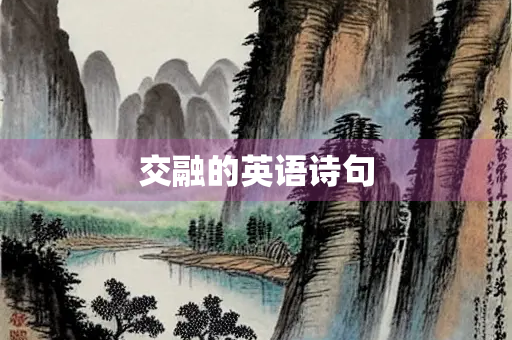
Intermingling is a term used to describe the blending and merging of different elements to create a new, unique entity. It is common in the world of poetry, where poets use language and imagery to create works that convey complex emotions and ideas. Throughout the history of English poetry, intermingling has been a recurring theme, with poets experimenting with various styles and techniques to produce works that are rich in meaning and beauty.
One of the most common forms of intermingling in English poetry is the use of light and darkness as symbols for opposing forces. Many poets have explored this theme, including William Blake, who wrote the iconic "Tiger, Tiger" poem, which features the tiger as an image of both beauty and danger:
Here, Blake intermingles the beauty of the tigers "burning bright" color with its "fearful symmetry," suggesting that there is no clear division between good and evil. In this sense, the poem can be seen as a meditation on the interplay between light and darkness in all aspects of life.
Another form of intermingling in English poetry is the blending of different styles and genres to create works that cross traditional boundaries. The Romantic poets of the 18th and 19th centuries were especially known for this, often combining elements of nature, emotion, and philosophy in their works.
For example, Samuel Taylor Coleridges "Kubla Khan" is a dreamlike poem that combines elements of fantasy, history, and natural imagery to create a wholly unique work:
Here, Coleridge blends Eastern and Western imagery to create a surreal landscape that suggests the fragility of human creativity and the power of nature to inspire and destroy.
Finally, many English poets have explored the intermingling of reality and imagination, using language to bridge these two disparate worlds. John Keats "Ode on a Grecian Urn" is a classic example of this, with Keats using the ancient urn as a symbol for the intersection between art and life:
Here, Keats invites the reader to enter into the world of the urn, blurring the boundaries between reality and imagination. He uses language to evoke a sense of mystery and wonder, creating a work that is both beautiful and thought-provoking.
Intermingling is a central theme in English poetry, as poets use language and imagery to create works that are rich in meaning and beauty. Whether experimenting with light and darkness, blending different styles and genres, or exploring the intersection of reality and imagination, English poets have been at the forefront of this artistic practice for centuries. By embracing intermingling, poets are able to create works that transcend traditional boundaries, inviting us to see the world in new and unexpected ways.
本文地址: https://www.shuiwy.com/a/38011.html
文章来源:im
版权声明:除非特别标注,否则均为本站原创文章,转载时请以链接形式注明文章出处。
2025-12-01im
2025-12-01im
2025-12-01im
2025-12-01im
2025-12-01im
2025-12-01im
2025-12-01im
2025-12-01im
2025-12-01im
2025-12-01im
2024-03-03im
2024-01-24im
2023-05-29im
2023-06-04im
2023-06-16im
2023-10-07im
2023-06-20im
2023-10-07im
2023-06-19im
2023-06-14im
2025-05-02im
2023-10-16im
2025-05-06im
2024-01-06im
2025-05-05im
2025-04-30im
2025-05-03im
2025-05-03im
2025-05-04im
2025-05-03im
扫码二维码
获取最新动态
